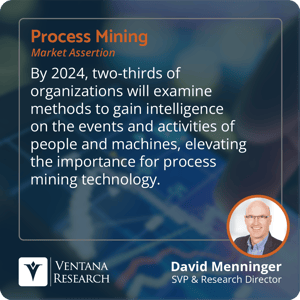Process mining is defined as the analysis of application telemetry including log files, transaction data and other instrumentation to understand and improve operational processes. Log data provides an abundance of information about what operations are occurring, the sequences involved in the processes, how long the processes are taking and whether or not the processes are completed successfully. As computing power has increased and storage costs have decreased, the economics of collecting and analyzing large amounts of log data have become much more attractive.
 Organizations can use process mining to better understand the current state of their systems and business processes. It can enable business process intelligence and improvement in any function or any industry by analyzing events and activity models to enable data-driven decision-making. By 2024, we assert that two-thirds of organizations will examine methods to gain intelligence on the events and activities of people and machines, elevating the importance for process mining technology.
Organizations can use process mining to better understand the current state of their systems and business processes. It can enable business process intelligence and improvement in any function or any industry by analyzing events and activity models to enable data-driven decision-making. By 2024, we assert that two-thirds of organizations will examine methods to gain intelligence on the events and activities of people and machines, elevating the importance for process mining technology.
Data is generated across multiple systems, and process mining can mine all this data in its multiple formats and across various sources of the process flow. Process analytics is used to integrate real-time data from various systems (including ERP, CRM, on-premises, cloud, etc.). that organizations can analyze to better understand how processes are running and what can be improved. Process mining incorporates various types of analytics including descriptive analytics, predictive analytics and prescriptive analytics based on specific requirements.
Process mining platforms typically include pre-built log file collectors and application connectors to make it easier to access all relevant information sources. Regardless of how many applications are supported out of the box, it’s likely that organizations will need to implement custom connectors as well, so the platform should include a toolkit for additional connectors. It also provides a framework for analyzing processes that includes sophisticated artificial intelligence and machine learning (AI/ML) capabilities to identify subtle relationships between steps in the process and across processes. These platforms also generally include a recommendation engine to help determine likely resolutions to the issues identified.
Understanding and analyzing operational processes in such detail can provide significant benefits. If an organization can identify processes that are bogged down and improve them, it can reduce the resources required for those processes. Once the resolutions to those business process issues have been identified, the next step would be to explore options to automate the solutions, further increasing efficiency. However, there are challenges to process mining the log data from various applications in an organization. Many organizations use custom applications which may not be easily accessible. It may be difficult to capture information from customized third-party applications as well. And organizations often use applications from a variety of vendors. Relating the information about processes that span multiple applications also presents challenges.
Process mining can be implemented across a wide variety of industries to help improve core processes and accelerate productivity. For example, process mining can be used in the supply chain industry to map the processes that occur in numerous aspects including manufacturing, warehousing, transportation, inventory management, retail management, etc. Then it can identify process gaps — unnecessary activities that increase the time to completion — and can provide recommendations on how these processes can be improved.
We are seeing a shift in the current IT landscape as more organizations are digitizing their processes and migrating to the cloud. Some of the challenges they encounter include merging disorganized log data from disparate systems and bringing it together for analysis and collaboration. Several vendors are working toward adding capabilities and functionalities to make process mining more effective. In the future, we expect that vendors will be adding more connectors, AI/ML and automation capabilities to their platforms to enhance customer experience and productivity. They will also move up the value chain to develop process mining applications for specific business processes and functions.
We have recently launched our Dynamic Insights research into process mining. Please participate in our research to help develop a profile of the state of process mining across a variety of organizations.
Regards,
David Menninger

 Organizations can use process mining to better understand the current state of their systems and business processes. It can enable
Organizations can use process mining to better understand the current state of their systems and business processes. It can enable 








